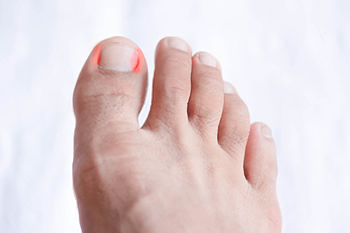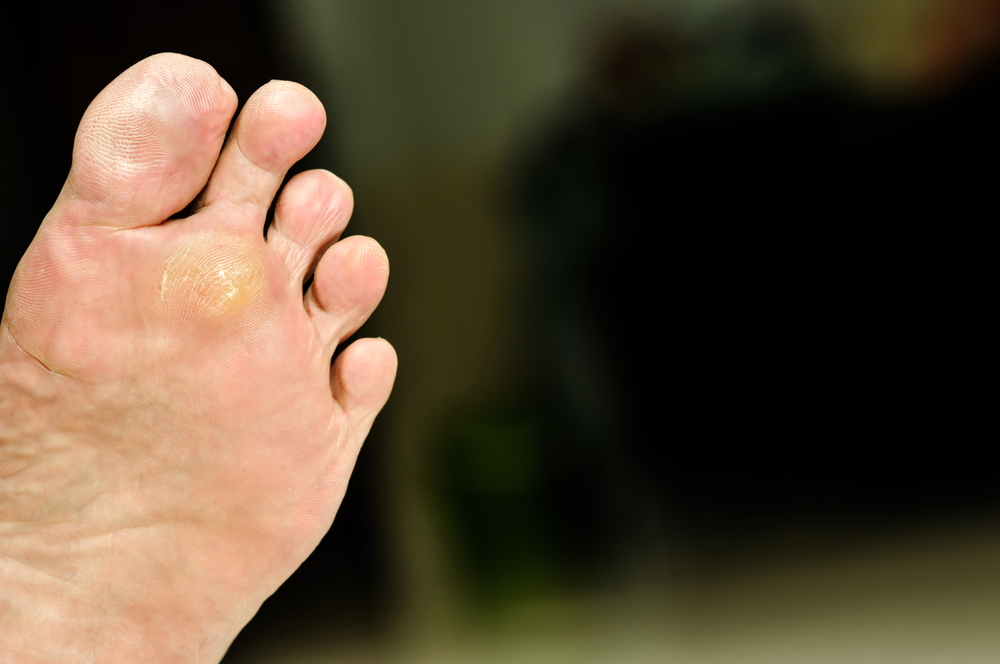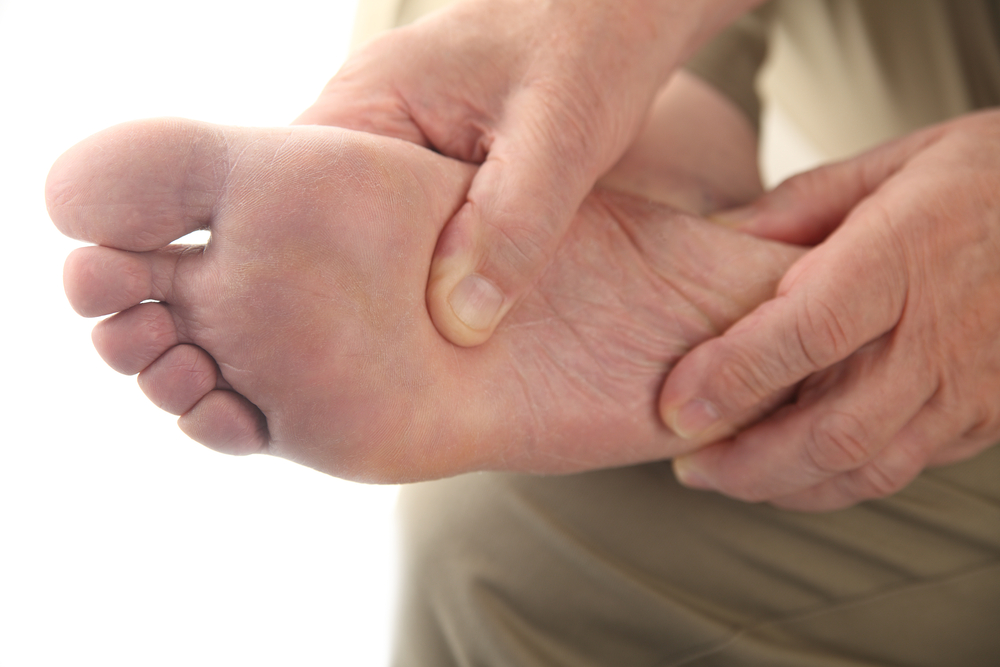
Drexel Hill (484) 521-0233
West Chester (610) 436-5883

Drexel Hill (484) 521-0233
West Chester (610) 436-5883
 The medical name for an ingrown toenail is known as onychocryptosis. This can happen as a result of the side of the toenail growing into the skin, and can cause severe pain and discomfort. Additional symptoms may include discharge draining from the affected area, and the side of the toe may appear swollen. A common reason an ingrown toenail may develop can be from shoes worn that do not have adequate room for the toes to move freely in. Trimming your toenails incorrectly may also cause an ingrown toenail. It is beneficial for the nails be trimmed straight across, and not too short. If you notice you have an ingrown toenail, it is advised that you are treated by a podiatrist who can help you to prevent an infection from occurring.
The medical name for an ingrown toenail is known as onychocryptosis. This can happen as a result of the side of the toenail growing into the skin, and can cause severe pain and discomfort. Additional symptoms may include discharge draining from the affected area, and the side of the toe may appear swollen. A common reason an ingrown toenail may develop can be from shoes worn that do not have adequate room for the toes to move freely in. Trimming your toenails incorrectly may also cause an ingrown toenail. It is beneficial for the nails be trimmed straight across, and not too short. If you notice you have an ingrown toenail, it is advised that you are treated by a podiatrist who can help you to prevent an infection from occurring.
Ingrown toenails can become painful if they are not treated properly. For more information about ingrown toenails, contact the podiatrists of Dr. Siegerman & Associates. Our doctors can provide the care you need to keep you pain-free and on your feet.
Ingrown Toenails
Ingrown toenails occur when a toenail grows sideways into the bed of the nail, causing pain, swelling, and possibly infection.
Causes
Prevention
Because ingrown toenails are not something found outside of shoe-wearing cultures, going barefoot as often as possible will decrease the likeliness of developing ingrown toenails. Wearing proper fitting shoes and using proper cutting techniques will also help decrease your risk of developing ingrown toenails.
Treatment
Ingrown toenails are a very treatable foot condition. In minor cases, soaking the affected area in salt or antibacterial soaps will not only help with the ingrown nail itself, but also help prevent any infections from occurring. In more severe cases, surgery is an option. In either case, speaking to your podiatrist about this condition will help you get a better understanding of specific treatment options that are right for you.
If you have any questions please feel free to contact one of our offices located in Drexel Hill and West Chester, PA . We offer the newest diagnostic and treatment technologies for all your foot and ankle needs.
 To begin treating your corn, it is important to understand what pressure or friction caused its development in the first place. Typically, the main reasons for a corn to form can be from standing for the majority of the day on a hard surface, and wearing tight or ill-fitting shoes which restrict the toes. They may also develop due to previous or existing foot conditions such as a bunion. In order for a corn to go away, the pressure that caused it must first be removed. If this pressure is not removed, the skin will remain hardened and sensitive to the touch. To help prevent this condition, it’s recommended that you dry your feet thoroughly after washing them and apply a moisturizer. Regularly using a pumice stone to remove hardened skin may also help to keep the skin smooth. Most importantly, ensure that your footwear fits properly and comfortably, and provides your toes with an adequate amount of room. To safely remove your corn, it is advised that you consult with a podiatrist for professional care and treatment.
To begin treating your corn, it is important to understand what pressure or friction caused its development in the first place. Typically, the main reasons for a corn to form can be from standing for the majority of the day on a hard surface, and wearing tight or ill-fitting shoes which restrict the toes. They may also develop due to previous or existing foot conditions such as a bunion. In order for a corn to go away, the pressure that caused it must first be removed. If this pressure is not removed, the skin will remain hardened and sensitive to the touch. To help prevent this condition, it’s recommended that you dry your feet thoroughly after washing them and apply a moisturizer. Regularly using a pumice stone to remove hardened skin may also help to keep the skin smooth. Most importantly, ensure that your footwear fits properly and comfortably, and provides your toes with an adequate amount of room. To safely remove your corn, it is advised that you consult with a podiatrist for professional care and treatment.
Corns can make walking very painful and should be treated immediately. If you have questions regarding your feet and ankles, contact the podiatrists of Dr. Siegerman & Associates. Our doctors will treat your foot and ankle needs.
Corns: What Are They? And How Do You Get Rid of Them?
Corns are thickened areas on the skin that can become painful. They are caused by excessive pressure and friction on the skin. Corns press into the deeper layers of the skin and are usually round in shape.
Ways to Prevent Corns
There are many ways to get rid of painful corns such as:
Treating Corns
Although most corns slowly disappear when the friction or pressure stops, this isn’t always the case. Consult with your podiatrist to determine the best treatment option for your case of corns.
If you have any questions please feel free to contact one of our offices located in Drexel Hill and West Chester, PA . We offer the newest diagnostic and treatment technologies for all your foot and ankle needs.
 Hammertoes can be identified as a toe with a significant downward bend in the middle joint, often appearing hammer-like, as its name suggests. This condition may come with an abundance of discomfort and pain. Hammertoes can often be associated with the development of corns, calluses, and bunions as well. Their development may be a result of genetics, or wearing ill-fitted shoes that don’t leave the toes enough room to move freely in. Other health complications, such as diabetes, can cause nerve damage, which may also lead to the formation of a hammertoe. Treatment of a hammertoe may vary depending on its severity and overall flexibility, or lack thereof. Flexible hammertoes may be treated through the use of custom orthotics, which are worn to help correct the positioning of the toe. Rigid hammertoes, however, may be corrected by having surgery performed, and are often done when conservative measures are found ineffective. To help diagnose which kind of hammertoe you have, and to determine which action should be taken for its treatment, it is recommended you consult with a podiatrist for professional advice and care.
Hammertoes can be identified as a toe with a significant downward bend in the middle joint, often appearing hammer-like, as its name suggests. This condition may come with an abundance of discomfort and pain. Hammertoes can often be associated with the development of corns, calluses, and bunions as well. Their development may be a result of genetics, or wearing ill-fitted shoes that don’t leave the toes enough room to move freely in. Other health complications, such as diabetes, can cause nerve damage, which may also lead to the formation of a hammertoe. Treatment of a hammertoe may vary depending on its severity and overall flexibility, or lack thereof. Flexible hammertoes may be treated through the use of custom orthotics, which are worn to help correct the positioning of the toe. Rigid hammertoes, however, may be corrected by having surgery performed, and are often done when conservative measures are found ineffective. To help diagnose which kind of hammertoe you have, and to determine which action should be taken for its treatment, it is recommended you consult with a podiatrist for professional advice and care.
Hammertoes can be a painful condition to live with. For more information, contact the podiatrists of Dr. Siegerman & Associates. Our doctors will answer any of your foot- and ankle-related questions.
Hammertoe
Hammertoe is a foot deformity that occurs due to an imbalance in the muscles, tendons, or ligaments that normally hold the toe straight. It can be caused by the type of shoes you wear, your foot structure, trauma, and certain disease processes.
Symptoms
Risk Factors
Treatment
If you have hammertoe, you should change into a more comfortable shoe that provides enough room for your toes. Exercises such as picking up marbles may strengthen and stretch your toe muscles. Nevertheless, it is important to seek assistance from a podiatrist in order to determine the severity of your hammertoe and see which treatment option will work best for you.
If you have any questions, please feel free to contact one of our offices located in Drexel Hill and West Chester, PA . We offer the newest diagnostic and treatment technologies for all your foot care needs.
 There are nerves that are located in each foot. If the nerve that is located between the third and fourth toes becomes inflamed, it may be referred to as Morton’s Neuroma. This condition may develop as a result of wearing shoes that do not have adequate room for the toes to move freely in, or from participating in high-impact sports. Some of the symptoms that are associated with Morton’s neuroma can include the sensation of stepping on a marble, pain and discomfort while walking, or feeling a burning or numbing sensation in the affected area. After a proper diagnosis is performed, which generally consists of having an X-ray or MRI taken, the correct treatment can begin. This may include a variety of options, which is why we advise that you seek the counsel of a podiatrist who can help you to determine which form of treatment is best for you.
There are nerves that are located in each foot. If the nerve that is located between the third and fourth toes becomes inflamed, it may be referred to as Morton’s Neuroma. This condition may develop as a result of wearing shoes that do not have adequate room for the toes to move freely in, or from participating in high-impact sports. Some of the symptoms that are associated with Morton’s neuroma can include the sensation of stepping on a marble, pain and discomfort while walking, or feeling a burning or numbing sensation in the affected area. After a proper diagnosis is performed, which generally consists of having an X-ray or MRI taken, the correct treatment can begin. This may include a variety of options, which is why we advise that you seek the counsel of a podiatrist who can help you to determine which form of treatment is best for you.
Morton’s neuroma is a very uncomfortable condition to live with. If you think you have Morton’s neuroma, contact the podiatrists of Dr. Siegerman & Associates. Our doctors will attend to all of your foot care needs and answer any of your related questions.
Morton’s Neuroma
Morton's neuroma is a painful foot condition that commonly affects the areas between the second and third or third and fourth toe, although other areas of the foot are also susceptible. Morton’s neuroma is caused by an inflamed nerve in the foot that is being squeezed and aggravated by surrounding bones.
What Increases the Chances of Having Morton’s Neuroma?
Morton’s neuroma is a very treatable condition. Orthotics and shoe inserts can often be used to alleviate the pain on the forefront of the feet. In more severe cases, corticosteroids can also be prescribed. In order to figure out the best treatment for your neuroma, it’s recommended to seek the care of a podiatrist who can diagnose your condition and provide different treatment options.
If you have any questions, please feel free to contact one of our offices located in Drexel Hill and West Chester, PA . We offer the newest diagnostic and treatment technologies for all your foot care needs.
Request a free copy of
Laser Away Foot Pain!
today.
